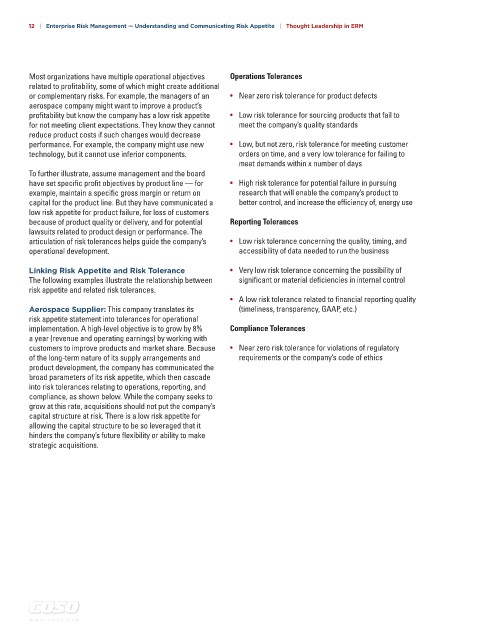Page 701 - COSO Guidance
P. 701
12 | Enterprise Risk Management — Understanding and Communicating Risk Appetite | Thought Leadership in ERM
Most organizations have multiple operational objectives Operations Tolerances
related to profitability, some of which might create additional
or complementary risks. For example, the managers of an • Near zero risk tolerance for product defects
aerospace company might want to improve a product’s
profitability but know the company has a low risk appetite • Low risk tolerance for sourcing products that fail to
for not meeting client expectations. They know they cannot meet the company’s quality standards
reduce product costs if such changes would decrease
performance. For example, the company might use new • Low, but not zero, risk tolerance for meeting customer
technology, but it cannot use inferior components. orders on time, and a very low tolerance for failing to
meet demands within x number of days
To further illustrate, assume management and the board
have set specific profit objectives by product line — for • High risk tolerance for potential failure in pursuing
example, maintain a specific gross margin or return on research that will enable the company’s product to
capital for the product line. But they have communicated a better control, and increase the efficiency of, energy use
low risk appetite for product failure, for loss of customers
because of product quality or delivery, and for potential Reporting Tolerances
lawsuits related to product design or performance. The
articulation of risk tolerances helps guide the company’s • Low risk tolerance concerning the quality, timing, and
operational development. accessibility of data needed to run the business
Linking Risk Appetite and Risk Tolerance • Very low risk tolerance concerning the possibility of
The following examples illustrate the relationship between significant or material deficiencies in internal control
risk appetite and related risk tolerances.
• A low risk tolerance related to financial reporting quality
Aerospace Supplier: This company translates its (timeliness, transparency, GAAP, etc.)
risk appetite statement into tolerances for operational
implementation. A high-level objective is to grow by 8% Compliance Tolerances
a year (revenue and operating earnings) by working with
customers to improve products and market share. Because • Near zero risk tolerance for violations of regulatory
of the long-term nature of its supply arrangements and requirements or the company’s code of ethics
product development, the company has communicated the
broad parameters of its risk appetite, which then cascade
into risk tolerances relating to operations, reporting, and
compliance, as shown below. While the company seeks to
grow at this rate, acquisitions should not put the company’s
capital structure at risk. There is a low risk appetite for
allowing the capital structure to be so leveraged that it
hinders the company’s future flexibility or ability to make
strategic acquisitions.
w w w . c o s o . o r g

